This article explains how to enable or disable Adaptive color in Windows 11.
Adaptive color is a feature that uses Ambient Color Sensors (ACS) to adjust your display’s color temperature based on the ambient light. This can help reduce eye strain and improve readability in different lighting conditions.
When enabled, the display will appear warmer in dim lighting and cooler in brighter environments.
Here’s why implementing Adaptive Color is beneficial:
- Consistent Visual Experience: Adaptive Color uses advanced sensors to adjust your display’s color and intensity to match the ambient light. Whether you’re working under the harsh fluorescents of an office or the soft glow of a reading lamp, Adaptive Color ensures the content on your screen looks natural and is comfortable to view at all times.
- Reduced Eye Strain: Adaptive Color can help minimize eye strain by dynamically adjusting to the environment, making it ideal for extended use. Whether reading, browsing, or working, Adaptive Color makes the display appear more natural, akin to reading a book under different lighting conditions.
- Enhanced Productivity: A display that adapts to your environment can lead to less fatigue and more comfortable working conditions, increasing productivity. Adaptive Color supports this by ensuring that colors and brightness are optimal for your current setting.
- A Smarter Display: Adaptive Color is like having an intelligent assistant for your screen, constantly working to give you the best viewing experience. It’s a subtle effect you might not notice until it’s turned off, but once you experience it, you’ll wonder how you ever did without it.
The Adaptive color feature is available when the device meets the following conditions: Graphics drivers with Brightness3 DDI support and a display that supports Ambient Color Sensor (ACS).
Turn on or off Adaptive Color in Windows 11
As mentioned, Adaptive color adjusts the color and brightness of your display to match the ambient light, making images appear more natural.
Here’s how to turn it on or off
First, open the Windows Settings app.
You can do that by clicking on the Start menu and selecting Settings. Or press the keyboard shortcut ( Windows key + I) to launch the Settings app.
When the Setting app opens, click the Display button on the left to expand it.

On the Display settings pane, select the “Adaptive color” tile. Then, toggle the switch to the On or Off button to enable or disable it.

This setting is stored to the IsAdaptiveColorOn REG_DWORD value in the Windows registry key below:
HKEY_LOCAL_MACHINE\SYSTEM\CurrentControlSet\Services\DisplayEnhancementService\State\SHP1234234345_24_02E23_876
The highlighted unique key is based on the display’s hardware ID and may differ on other systems.
0 = Off
1 = On
You may have to restart your computer for the changes to take effect.

That should do it!
Reference:
Conclusion:
- Adaptive Color in Windows 11 provides a consistent visual experience based on ambient lighting, reducing eye strain and enhancing productivity.
- By dynamically adjusting the display’s color and intensity to match the environment, Adaptive Color makes the screen more comfortable to view in various lighting conditions.
- Enabling or disabling Adaptive Color in Windows 11 can be done through the Display settings pane in the Windows Settings app.
- Remember that the changes may require a computer restart, so ensure the new color settings are properly applied.

Leave a Reply Cancel reply